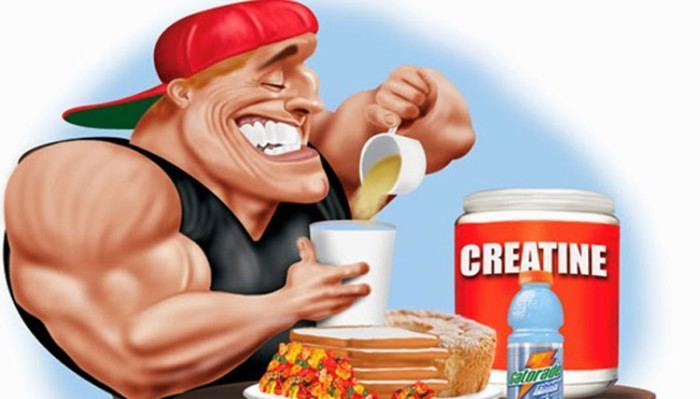Stronger, fitter, better—the constant grind of a high achieving CrossFitter… which is all of you.
Every. Single. One.
How do I know this? Because CrossFit attracts high achievers, of which I can write about for days, but I digress…
 Creatine Monohydrate is the muscle building king and will absolutely serve your fitness goals.
Creatine Monohydrate is the muscle building king and will absolutely serve your fitness goals.
Before I get carried away with my love for the product (and for you all), let’s square away some historical long-standing confusion surrounding the most utilised form of creatine- creatine monohydrate. If you’ve ever had any interest in the product, you would’ve surely come across all of the associated bro-science on the safety of it. Let’s take a look at some of the true science…
What is it?
It’s a super chemical created by world famous bodybuilder, Tony Stark… Joking- quite the contrary! Creatine monohydrate is an amino acid derivative found naturally in meats like beef and fish. It is comprised of the three amino acids; glycine, methionine and arginine, which are bound to a water molecule (monohydrate). Our bodies produce it naturally at a rate of about 1-2 grams/day in the kidneys, pancreas and liver, which is then stored in skeletal muscle as creatine phosphate.
How does it work?
 When our stored creatine phosphate undergoes certain metabolic processes, it donates its phosphate molecule.
When our stored creatine phosphate undergoes certain metabolic processes, it donates its phosphate molecule.
Enough with the science, Jamie… so what? Stay with me… You may have heard of a little thing called Adenosine Tri-Phosphate (ATP) – the body’s energy currency. This baby uses phosphate to power certain cellular processes and is present in your body, ready for action… but just enough for a few seconds.
When we undergo brief, powerful and rapid movements lasting less than ~10 seconds, ATP is broken down into Adenosine Di-Phosphate (ADP), resulting in the loss of a phosphate molecule. Loss of this phosphate is what provides the energy to power our cells during any activity. In order to make more ATP, the body needs to find the third phosphate, fast!
As ATP stores deplete, performance can suffer. Enter creatine phosphate. Creatine phosphate takes one for the team by donating it’s phosphate to ADP so it can reform ATP. Hence improving performance and increasing strength and power.
How does this help us in CrossFit (& in life)?
Increased creatine means increased potential for ATP → improved performance in high-intensity, short duration task. For the most part, this is CrossFit! For those big, long, arduous chipper fans, creatine may still help you. Although long-duration, low-intensity activities rely more on a different energy system, in which creatine is redundant, recently creatine has also been linked to assisting in muscle recovery. A study compiled in 2004 concluded that muscle cell damage and inflammation was reduced with creatine supplementation in endurance athletes after running a 30km race. The following statement was issued by the researchers:
“It seems creatine also helps to promote complete recovery from intense exercise. Another reason strength and endurance athletes may benefit from its use.”
But wait, there’s more…
Creatine has also been shown to be an extremely important neuroprotectant (an agent that increases the survival of nerve cells). The prestigious Neuroscience published a study that found creatine enhances brain function (specifically short-term memory), plus helps in the prevention and treatment of neurodegenerative disorders.
Doesn’t it make you bloated?
Short answer- No. Creatine uptake into cells has a hydrating effect and thus promotes skeletal muscle cell volumising. Key message here is SKELETAL MUSCLE… if anything you’ll see increase muscle definition, not bloating.
Where can you get it?
True Protein! If you already take the True Pre & True Post, then you’re getting an adequate daily dose (and I bet you’ve noticed the benefits). Both blends contain 2.5g, totaling the required 5g/day to maintain optimal levels within skeletal muscle. I’ll cover the many other benefits of TPs Pre & Post in another post, but for those of you who haven’t jumped on that band wagon, you can buy good, pure creatine monohydrate either from True Protein (Stace can hook you up), or at most supplement stores.
Why creatine monohydrate?
Because the phosphorylated form (creatine phosphate) cannot pass through the cell membrane. It is also the most common form, of which most studies are based on. The main reason for this is because it is the most concentrated form, providing 88% pure creatine per molecule.
So, if your goal is to get bigger, stronger, and maybe even lift longer and heavier, creatine can help. If you’re not trying to do any of these things, go take a nap and come back when you are ready.
References
Powers, ME. et al. “Creatine Supplementation Increases Total Body Water Without Altering Fluid Distribution.” Journal of Athletic Training 38.1, 2003: 44–50 https://www.ncbi.nlm.nih.gov/pmc/articles/PMC155510/
Spillane M, et al. “The effects of creatine ethyl ester supplementation combined with heavy resistance training on body composition, muscle performance, and serum and muscle creatine levels.” Journal of the International Society of Sports Nutrition 2009 6:6 https://doi.org/10.1186/1550-2783-6-6
Greenhaff, PL; Casey, A; Short, AH; Harris, RC; Soderlund, K and Hultman, E. Influence of oral creatine supplementation on muscle torque during repeated bouts of maximal voluntary exercise in man. Clinical Science, 1993, 84:565-571.
Santos, R. V. et al. “The effect of creatine supplementation upon inflammatory and muscle soreness markers after a 30km race.” Life Sciences, 2004, Volume 75(16), pages 1917-1924.
Wyss, M. and Schulze, A. “Health implications of creatine: Can oral creatine supplementation protect against neurological and atherosclerotic disease?”, Neuroscience, Volume 112 (2) 2002, pages 243-260.
